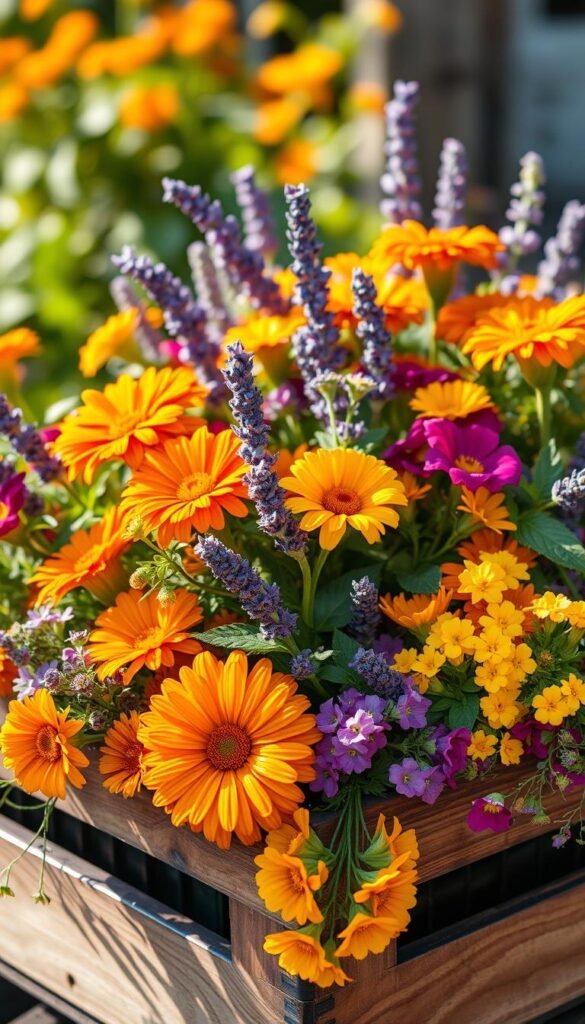Imagine adding vibrant colors and delicate flavors to your meals with ingredients grown steps from your kitchen. Bright petals can transform ordinary dishes into works of art, while subtle floral notes elevate drinks and desserts. With the right knowledge, you’ll unlock endless ways to make every meal feel special.
Before diving in, always confirm which varieties are safe to eat. Some plants may look appealing but have bitter tastes or unwanted textures. A little research ensures you pick options that delight both the eyes and palate.
Growing your own ensures freshness and quality. You’ll avoid pesticides while experimenting with unique flavors—think peppery nasturtiums or citrusy calendula. Even small spaces thrive with container-friendly choices like pansies or violets.
This guide covers everything from selecting the best blooms to designing a functional yet beautiful growing area. Discover how to pair flavors with meals, preserve petals for year-round use, and create showstopping presentations. Whether you’re a seasoned cook or new to gardening, you’ll find simple strategies to grow success.
Understanding Edible Flowers: A Culinary Adventure
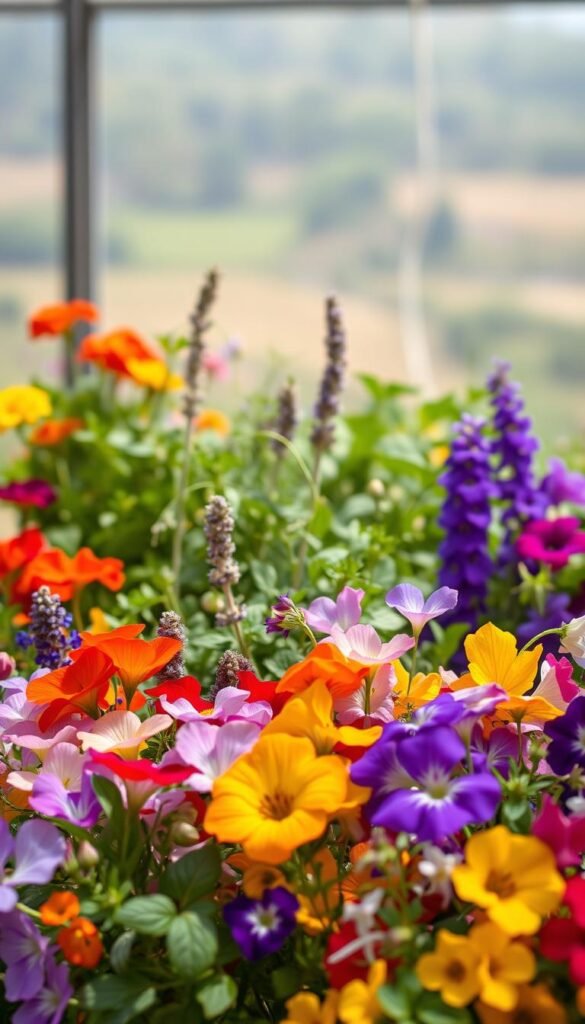
Not all blossoms are just for looks—some bring unique tastes to your table. Knowing which petals are safe to eat requires careful research, as certain varieties may look appealing but contain harmful compounds. Start by verifying a plant’s edibility through trusted resources like this guide to safe options before harvesting.
What Makes a Flower Edible?
Safety comes first. Only consume petals grown without pesticides or chemicals. Key factors include their natural composition, absence of toxins, and pleasant texture. For example, roses and lavender are popular choices, while foxglove and oleander should always be avoided.
Flavor Profiles and Culinary Versatility
Each bloom offers distinct characteristics. Nasturtiums deliver a peppery kick, while hibiscus adds tartness to teas. Mild options like pansies work well as garnishes, and fragrant herbs like chive blossoms enhance savory dishes. Remember: stronger flavors pair best with bold ingredients, while delicate ones shine in desserts or drinks.
Beyond taste, many petals pack nutrients like antioxidants. Experiment with fresh additions to salads or preserved petals for year-round use. With the right pairings, you’ll turn meals into multisensory experiences.
Designing Your Edible Flower Garden
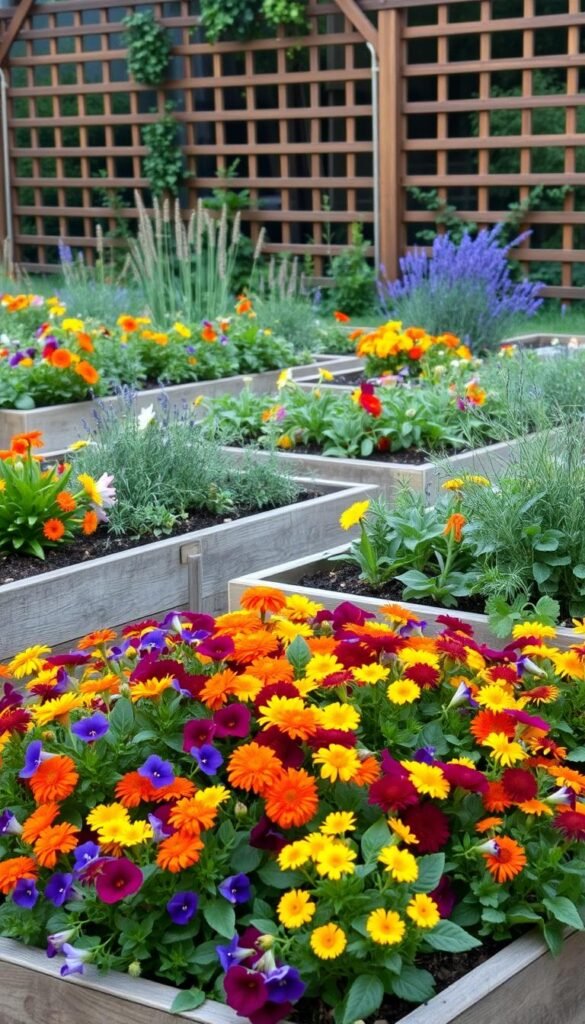
Your outdoor space can become both a visual feast and a pantry of flavors with thoughtful design. Focus on balancing aesthetics with practicality—after all, you’ll want easy access to petals while they’re at their freshest. Let’s explore how to create a layout that’s as functional as it is beautiful.
Choosing the Perfect Location
Most sun-loving varieties need 6–8 hours of direct light daily to develop bold flavors. Test your soil’s pH—slightly alkaline to neutral levels work best for many types. If your yard has heavy clay or poor drainage, colorful container gardening offers a flexible solution.
Pick a spot near your kitchen for quick harvesting. Delicate petals wilt fast, so convenience matters. Ensure the area has good airflow to prevent mold but isn’t too windy for tender stems.
Planning a Colorful Layout
Arrange taller plants like sunflowers at the back and compact ones like chive blossoms up front. This creates depth while ensuring every variety gets enough light. Mix annuals and perennials for nonstop blooms—marigolds add summer vibrancy, while echinacea returns yearly.
Group similar hues for bold swaths of color or blend shades for a whimsical meadow look. Leave pathways between beds for easy care and harvesting. With smart placement, your plot becomes a living palette you can snack on!
Best Edible Flowers for Salads and Garnishes
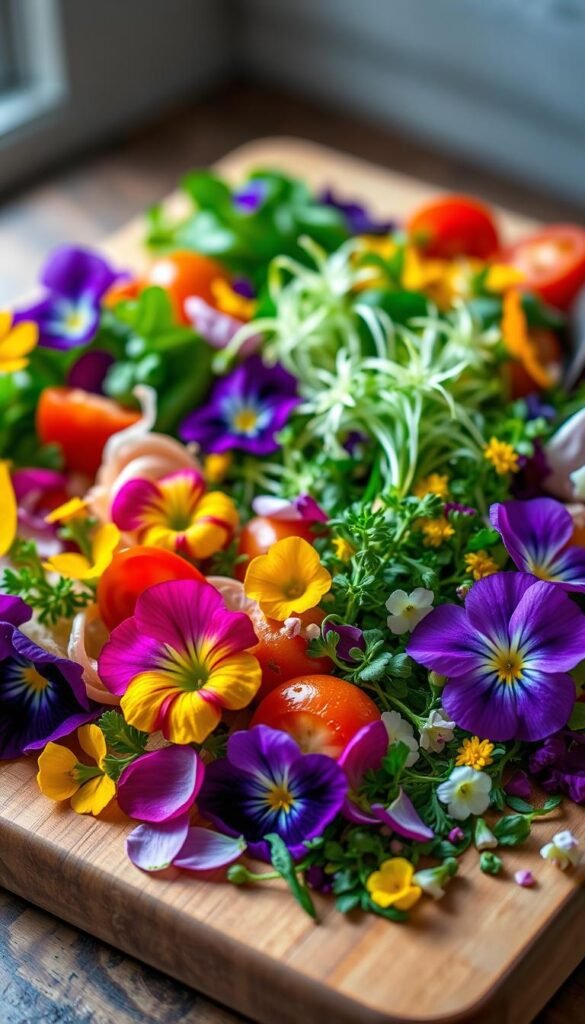
Bright petals can turn simple meals into culinary masterpieces. The right varieties bring both visual appeal and unexpected flavors to your creations. Let’s explore top performers that thrive in gardens and elevate everyday dishes.
Top Varieties and Their Tastes
Nasturtiums steal the spotlight with their peppery zing and sunset-colored blooms. Their whole blossoms add crunch to leafy mixes or act as bold plate decor. Bonus: They’re packed with vitamin C!
Pansies offer delicate sweetness with hints of fresh grass. Press them into cheesecakes or freeze in ice cubes for elegant drinks. Their flat shape makes them ideal for decorating frosted desserts.
Chive blossoms burst with mild onion flavor. Break apart their purple clusters to sprinkle over potato salad or avocado toast. They’re a must-try for savory dishes needing subtle depth.
Calendula petals mimic saffron’s golden hue at a fraction of the cost. Stir them into risottos or blend into herb butter. Their tangy kick balances creamy textures beautifully.
Borage blooms surprise with cucumber freshness and star-shaped beauty. Float them in lemonade or tuck into tea sandwiches. Dianthus adds spice like clove, perfect for fruit salads when trimmed properly.
Edible Flower Garden: Culinary Blooms for Salads, Teas, and Garnishes
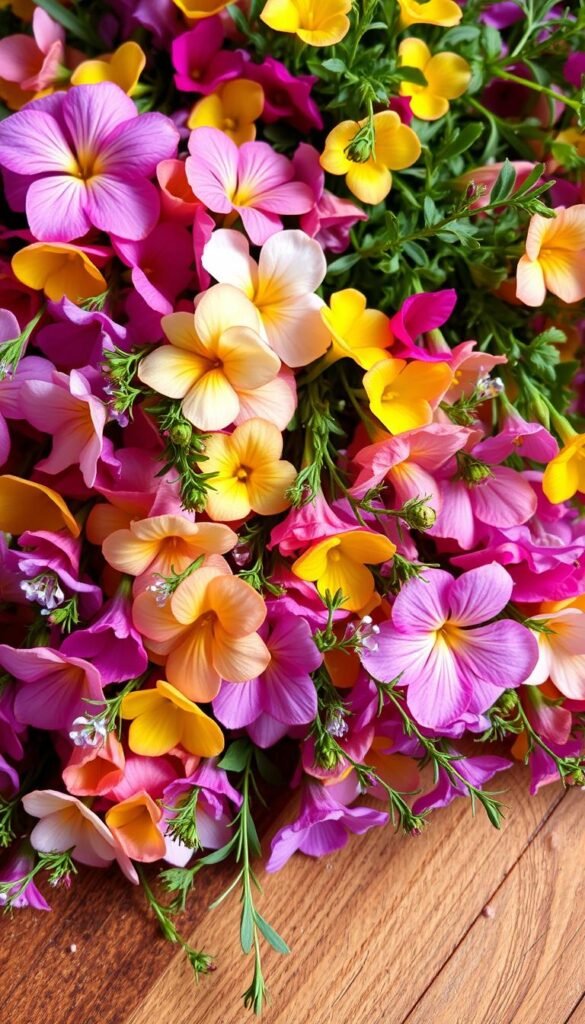
Transform everyday meals into unforgettable experiences with petals that do double duty as ingredients and art. Whether folded into recipes or used as finishing touches, these natural accents add depth to your cooking while showcasing garden-fresh creativity.
Signature Dishes and Creative Garnishing Ideas
Stuffed squash blossoms make impressive starters. Fill them with herbed ricotta, dip in tempura batter, and fry until golden. The result? Crispy exteriors with creamy centers that let the flower’s natural sweetness shine.
| Flower Varieties | Dish Pairing | Garnish Uses |
|---|---|---|
| Squash Blossoms | Fried appetizers | Plate lining |
| Rose Petals | Ice cream toppings | Cocktail cubes |
| Lavender | Shortbread cookies | Dessert dusting |
Highlighting Unique Flower Flavors
Balance bold and delicate tastes. Peppery nasturtium leaves wrap goat cheese beautifully, while violet petals add floral sweetness to lemon tarts. Mix petals into compound butter for bread spreads or blend with salt for gourmet finishing touches.
Stronger flavors work best in small doses. Try lavender honey drizzled over vanilla ice cream or chive blossoms in savory dips. Let subtle varieties like pansies take center stage in chilled soups or fruit salads.
Growing Edible Flowers in Vegetable and Herb Gardens
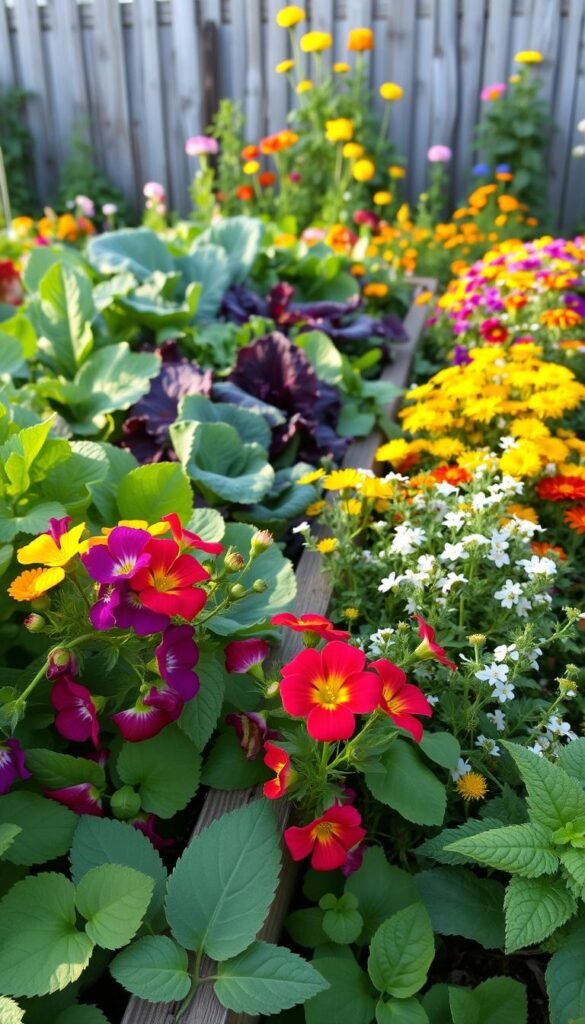
Your vegetable patch can double as a flavor powerhouse when you let plants reach their full potential. Many common crops produce blossoms that surprise with bold tastes and visual appeal. By blending these into your existing beds, you create a space where every leaf and petal serves multiple purposes.
Smart Pairings for Flavor and Function
Arugula’s white flowers deliver the same peppery kick as its leaves—perfect for spicing up green salads. Let some plants bolt intentionally to enjoy this bonus harvest. Broccoli’s sunny yellow blooms add mild crunch to stir-fries when picked before seed pods form.
Fennel’s feathery umbels offer subtle licorice notes. Sprinkle them over grilled fish or steep in olive oil for dressings. Pea blossoms taste like springtime sweetness and pair beautifully with fresh shoots in garden-to-table dishes.
| Vegetable | Flower Taste | Best Uses |
|---|---|---|
| Arugula | Peppery | Salad accents |
| Runner Bean | Mild bean | Hummingbird attractors |
| Squash | Subtle sweetness | Stuffed appetizers |
Vertical growers like runner beans serve triple duty. Their scarlet flowers brighten herb gardens, attract pollinators, and make striking table centerpieces. Squash blossoms shine when stuffed with ricotta and lightly fried—a crispy treat hiding creamy goodness.
This approach transforms your garden into a living pantry. You’ll enjoy continuous harvests while supporting beneficial insects. Why choose between veggies and blossoms when you can have both?
Tips for Harvesting and Storing Fresh Edible Flowers
Preserving the vibrant beauty and flavor of your blooms starts the moment you pick them. With simple techniques, you’ll keep petals fresh longer and maintain their peak taste for recipes.
Optimal Harvesting Times
Head out in the early morning when blooms are plump with dew but fully dry. This time captures the highest concentration of aromatic oils. Choose blossoms that just opened—their petals are tender and flavors brightest.
Avoid midday heat or damp conditions. Moisture speeds spoilage, while sun exposure fades colors. Use sharp scissors to snip stems cleanly, leaving enough length for handling.
Proper Cleaning and Storage Techniques
Gently swirl blooms in a bowl of cold water to remove dirt. Sturdy varieties like calendula handle rinsing well, while fragile pansies need pat-drying with paper towels.
Layer cleaned flowers between damp towels in airtight containers. Refrigerate immediately—most last 3-4 days this way. For quick use, place petals on ice in a sealed bag to lock in freshness.
Cooking with Edible Flowers: Dishes, Teas, and More
Your kitchen becomes an artist’s studio when you cook with nature’s colorful ingredients. Fresh petals offer endless ways to upgrade meals—from refreshing drinks to vibrant plates. Start simple by sprinkling a few blossoms over familiar favorites, then explore creative combinations.
Recipe Ideas for Fresh Creations
Add peppery nasturtiums to leafy greens for a bold twist. Mild pansies blend beautifully into summer rolls or grain bowls. For drinks, steep chamomile buds in hot water for calming tea, or freeze lavender sprigs into lemonade cubes.
Mastering Flavor Harmony
Balance is key. Pair strong tastes like rosemary blossoms with honey or citrus. Delicate varieties shine in light dishes—try rose petals in vanilla yogurt. Always add petals last to preserve texture and aroma.
Remember: less is often more. A few well-chosen blooms elevate dishes without overpowering. Keep experimenting—you’ll discover surprising matches that make every bite memorable!

